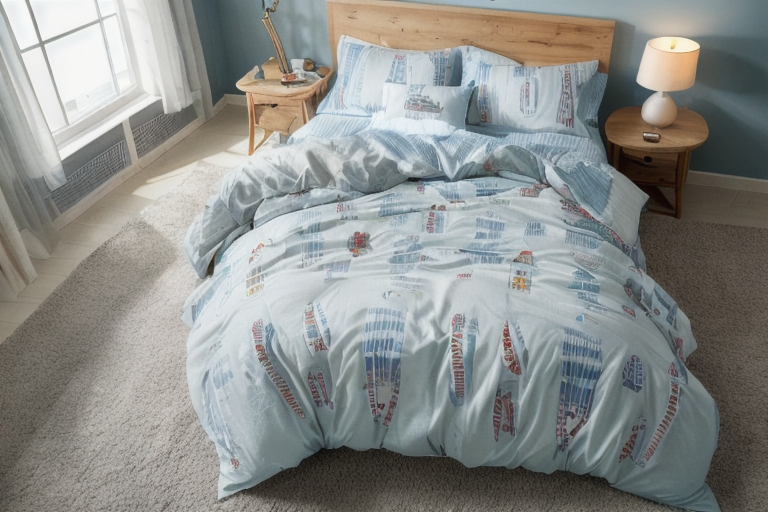Down comforters are popular for their unmatched warmth and coziness, but concerns over lung health and animal welfare have raised questions about their safety. This definitive guide explores both sides to help you make an informed decision.
What are Down Comforters?
Down comforters are filled with the fine, fluffy undercoating found beneath the tougher exterior feathers of ducks and geese. This natural down insulation traps air to provide exceptional warmth while remaining lightweight and breathable for comfort.
Down dominated the comforter market for decades due to these unbeatable properties. However, the growth of down alternatives, driven by health worries and ethical factors, means consumers now have more choice.
Are Down Comforters Safe for Your Lung Health?
For most people, down comforters present minimal risks. But for those with severe asthma, allergies, or compromised immunity, certain precautions should be taken.
Hypersensitivity Pneumonitis and Feather Duvet Lung
Rare but serious lung conditions like Hypersensitivity Pneumonitis and Feather Duvet Lung are associated with down bedding exposure over months or years. Symptoms include:
- Coughing
- Breathing difficulties
- Lung inflammation
The exact causes are uncertain but likely involve an immune reaction to organic dust particles from the down itself or dust mites accumulated within the filling.
Mold or mildew buildup exacerbated by improper storage in humid conditions may also play a role. Those susceptible likely have a genetic predisposition.
While frightening, most enjoy down comforters their whole life without issue. Reasonable precautions minimize any risks.
Allergens in Down Bedding
More commonly, down can irritate those with allergies. As natural products, down and feathers contain proteins that can trigger reactions, especially when inhaled.
Allergic rhinitis symptoms like sneezing, congestion, and runny nose are most typical. Asthma flare-ups are also possible in severe cases.
That said, quality down itself is not inherently allergenic. Issues instead arise from dust mite droppings and other allergen buildup over time. Proper maintenance is key for avoiding this.
| cause | symptoms |
|---|---|
| Dust Mites | Sneezing, congestion, asthma |
| Mold and Mildew | Coughing, lung inflammation |
Do Down Alternatives Exist?

For those with lung conditions or severe allergies, down alternative comforters eliminate risks while offering other perks.
Synthetic and Natural Materials
Today’s down alternatives mimic the cozy warmth and breathability of down using innovative synthetic fills like PrimaLoft or natural fabrics like organic cotton. Choices include:
- Polyester – Budget-friendly and durable
- Microfiber – Light, hypoallergenic, affordable
- Cotton – Natural, breathable, machine-washable
- Silk – Luxurious, temperature-regulating
- Wool – Natural insulation, moisture-wicking
While generally less lofty and luxurious than quality down, improvements in synthetic tech like 3D airflow make alternatives more competitive every year.
Cost Comparison
- Down – $200 to $500+
- Synthetic – $50 to $250
- Cotton – $100 to $300
- Silk – $250 to $500+
- Wool – $200 to $400
So while down still commands a premium, competitive options exist at every price point.
Ethical Down: Sourcing Matters
Animal cruelty concerns also spotlight down production practices. Thankfully, consumers have power through their purchases.
Live Plucking and Animal Welfare Issues
Most down is properly sourced as a byproduct of waterfowl processed for meat. But exceptions exist.
Live-plucking causes extreme distress by ripping feathers from undeaned birds. Though banned in responsible supply chains, animal welfare groups have documented the abusive practice at some farms.
Thankfully, consumers can support cruelty-free down through certifications like the Responsible Down Standard. Top brands now prioritize ethical sourcing.
Emerging Alternatives
Those seeking down warmth from ethical sources can now choose:
- Recycled/Traceable Down – Repurposes feathers from apparel production rather than farm harvests. Traceable to never involve live plucking.
- Eiderdown – Harvests rare eider duck down shed naturally during nesting season causes no distress. However, small supply and preservation challenges limit wider adoption.
For vegans, even responsibly-sourced down remains an animal product. Increasingly popular vegan comforters mimic down using plant-based fibers likes kapok.
Shopping for Safe and Ethical Down

Choosing an allergy-friendly, responsibly-sourced down comforter means checking a few key details:
Seek Proper Certifications
Reputable down comforter brands display trusted third-party certifications proving:
- Materials safely tested for harmful substances (OEKO-TEX Standard 100)
- Responsible down sourcing (Responsible Down Standard)
- Production processes avoiding allergen risk (Downpass)
Certifications provide assurance, not guarantees. But combined with other precautions significantly minimize risks.
Compare Fill Powers
Fill power measures volume loft – higher numbers equal more insulation from less down:
- Under 500 – Lowest quality down and power
- 600 to 800 – Mid-range, suitable for most
- Over 800 – Maximum loft, premium warmth
Higher fill powers trap more air with less material. This results in increased breathability, durability and hypoallergenic properties.
Prioritize Quality Materials
Down fill should have resilience, loft and proper cleaning. But the outer fabric matters too, with tightly-woven, high thread counts inhibiting allergen buildup. Materials like cambric cotton or sateen weave excel here.
A final protective barrier comes from a dust mite-proof cover encasing the comforter.
Caring for Down Comforters
To enjoy down comforters safely long-term, proper maintenance prevents allergen buildup for years of cozy warmth.
Frequent Cleaning Essential
Clean down at least twice yearly according to manufacture guidelines. Typical care includes:
- Machine wash gentle cycle with mild detergent
- Multiple freshwater rinse cycles
- Air dry completely before storage
Proper drying preserves maximum loft and minimizing allergen risks from moisture. Consider professional laundering for large comforters.
Use Down-Proof Covers
Encasing the comforter in an airtight, protective cover creates an impenetrable barrier against dust mites. Quality covers also prevent down escaping through damaged fabric.
Know Replacement Timeframes
With proper care, quality down comforters provide lasting performance:
- Lower fill powers: 6 years
- Medium fill powers: 8-10 years
- High fill powers: 12+ years
But a decrease in warmth and loft over time means eventual replacement. Budget-friendly synthetics may need upgrading more frequently.
The Takeaway – Enjoy Down Comforters Safely
For most, down comforters offer exceptional comfort and durability, with allergy risks easily minimized through informed shopping and responsible maintenance. And consumers should reward brands ensuring responsible sourcing.
But those with chronic lung issues or committed vegans may prefer high-quality down alternatives for complete peace of mind.
Whichever you choose, take steps to care for your bedding properly and replace when needed. Follow these essential tips for enjoying cozy, allergen-free comfort for years.
Frequently Asked Questions
Are down comforters safe if I have asthma?
For most asthma sufferers, down comforters present minimal risks, especially with covers. But those with severe allergies should consider alternatives.
What’s the difference between down and feathers?
Down refers to the soft, fluffy clusters beneath tougher exterior feathers. Higher-quality down provides better insulation and hypoallergenic properties.
How often should you clean a down comforter?
Clean down comforters at least twice yearly according to manufacturer instructions to prevent allergen and dust mite buildup. Proper drying is also critical.
What fill power is best?
Higher fill powers of 600+ provide better warmth, loft and breathability from less down. But under 500 still serves most budgets.
Can you put a down comforter in the dryer?
Only use air drying, which preserves maximum loft and performance. Machine drying risks clumping and damage.
What is the warmest down alternative?
Innovative synthetic fills like PrimaLoft now approach quality down’s warmth. Wool, silk and high-fill polyester also excel at insulation.
How long do down comforters last?
With proper care like frequent washing, storage, and use of covers, quality down comforters provide 10-12+ years of cozy durability before losing efficiency.








